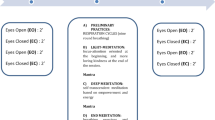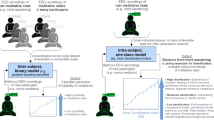Abstract
In the modern world, it is easy to get lost in thought, partly because of the vast knowledge available at our fingertips via smartphones that divide our cognitive resources and partly because of our intrinsic thoughts. In this work, we aim to find the differences in the neural signatures of mind-wandering and meditation that are common across different meditative styles. We use EEG recording done during meditation sessions by experts of different meditative styles, namely shamatha, zazen, dzogchen, and visualization. We evaluate the models using the leave-one-out validation technique to train on three meditative styles and test the fourth left-out style. With this method, we achieve an average classification accuracy of above 70%, suggesting that EEG signals of meditation techniques have a unique neural signature across meditative styles and can be differentiated from mind-wandering states. In addition, we generate lower-dimensional embeddings from higher-dimensional ones using t-SNE, PCA, and LLE algorithms and observe visual differences in embeddings between meditation and mind-wandering. We also discuss the general flow of the proposed design and contributions to the field of neuro-feedback-enabled mind-wandering detection and correction devices.
Access this chapter
Tax calculation will be finalised at checkout
Purchases are for personal use only
Similar content being viewed by others
References
Meditation: In depth. https://www.nccih.nih.gov/health/meditation-in-depth
Deng, Y.Q., Li, S., Tang, Y.Y.: The relationship between wandering mind, depression and mindfulness. Mindfulness 5(2), 124–128 (2014)
Dong, H.W., Mills, C., Knight, R.T., Kam, J.W.: Detection of mind wandering using EEG: within and across individuals. PLoS ONE 16(5), e0251490 (2021)
Galway, L., Brennan, C., McCullagh, P., Lightbody, G.: BCI and eye gaze: collaboration at the interface. In: Schmorrow, D.D., Fidopiastis, C.M. (eds.) AC 2015. LNCS (LNAI), vol. 9183, pp. 199–210. Springer, Cham (2015). https://doi.org/10.1007/978-3-319-20816-9_20
Gramfort, A., et al.: MEG and EEG data analysis with MNE-Python. Front. Neurosci. 7(267), 1–13 (2013). https://doi.org/10.3389/fnins.2013.00267
Kingma, D.P., Ba, J.: Adam: a method for stochastic optimization (2017)
Kora, P., Meenakshi, K., Swaraja, K., Rajani, A., Raju, M.S.: EEG based interpretation of human brain activity during yoga and meditation using machine learning: a systematic review. Complement. Ther. Clin. Pract. 43, 101329 (2021)
Lomas, T., Cartwright, T., Edginton, T., Ridge, D.: A qualitative analysis of experiential challenges associated with meditation practice. Mindfulness 6(4), 848–860 (2015)
Van der Maaten, L., Hinton, G.: Visualizing data using t-SNE. J. Mach. Learn. Res. 9(11) (2008)
Mahmud, M., Kaiser, M.S., Hussain, A., Vassanelli, S.: Applications of deep learning and reinforcement learning to biological data. IEEE Trans. Neural Netw. Learn. Syst. 29(6), 2063–2079 (2018). https://doi.org/10.1109/TNNLS.2018.2790388
Mooneyham, B.W., Schooler, J.W.: The costs and benefits of mind-wandering: a review. Can. J. Exp. Psychol./Revue canadienne de psychologie expérimentale 67(1), 11 (2013)
Pandey, P., Gupta, P., Miyapuram, K.P.: Brain connectivity based classification of meditation expertise. In: Mahmud, M., Kaiser, M.S., Vassanelli, S., Dai, Q., Zhong, N. (eds.) BI 2021. LNCS (LNAI), vol. 12960, pp. 89–98. Springer, Cham (2021). https://doi.org/10.1007/978-3-030-86993-9_9
Pandey, P., Miyapuram, K.P.: Classifying oscillatory signatures of expert vs nonexpert meditators. In: 2020 International Joint Conference on Neural Networks (IJCNN), pp. 1–7. IEEE (2020)
Pandey, P., Miyapuram, K.P.: BRAIN2DEPTH: lightweight CNN model for classification of cognitive states from EEG recordings. In: Papież, B.W., Yaqub, M., Jiao, J., Namburete, A.I.L., Noble, J.A. (eds.) MIUA 2021. LNCS, vol. 12722, pp. 394–407. Springer, Cham (2021). https://doi.org/10.1007/978-3-030-80432-9_30
Pandey, P., Miyapuram, K.P.: Nonlinear EEG analysis of mindfulness training using interpretable machine learning. In: 2021 IEEE International Conference on Bioinformatics and Biomedicine (BIBM), pp. 3051–3057 (2021). https://doi.org/10.1109/BIBM52615.2021.9669457
Gupta, P., Pandey, P., Miyapuram, K.P.: Reliable EEG neuromarker to discriminate meditative states across practitioners (2022). https://doi.org/10.13140/RG.2.2.23937.94568
Ribeiro, M.T., Singh, S., Guestrin, C.: “Why should i trust you?” Explaining the predictions of any classifier. In: Proceedings of the 22nd ACM SIGKDD International Conference on Knowledge Discovery and Data Mining, pp. 1135–1144 (2016)
Roweis, S.T., Saul, L.K.: Nonlinear dimensionality reduction by locally linear embedding. Science 290(5500), 2323–2326 (2000)
Sharma, H., Raj, R., Juneja, M.: An empirical comparison of machine learning algorithms for the classification of brain signals to assess the impact of combined yoga and sudarshan kriya. Comput. Methods Biomech. Biomed. Eng. 25, 1–8 (2021)
Vallat, R., Walker, M.P.: An open-source, high-performance tool for automated sleep staging. eLife 10, e70092 (2021). https://doi.org/10.7554/elife.70092
Vivot, R.M., Pallavicini, C., Zamberlan, F., Vigo, D., Tagliazucchi, E.: Meditation increases the entropy of brain oscillatory activity. Neuroscience 431, 40–51 (2020)
West, M.: Meditation. Br. J. Psychiatry 135(5), 457–467 (1979). https://doi.org/10.1192/bjp.135.5.457
Yamaoka, A., Yukawa, S.: Mind wandering in creative problem-solving: relationships with divergent thinking and mental health. PLoS ONE 15(4), e0231946 (2020)
Young, J.H., Arterberry, M.E., Martin, J.P.: Contrasting electroencephalography-derived entropy and neural oscillations with highly skilled meditators. Front. Hum. Neurosci. 15, 628417 (2021). https://doi.org/10.3389/fnhum.2021.628417. https://www.frontiersin.org/article/10.3389/fnhum.2021.628417
Zhang, Y., Zhang, Z., Luo, L., Tong, H., Chen, F., Hou, S.T.: 40 HZ light flicker alters human brain electroencephalography microstates and complexity implicated in brain diseases. Front. Neurosci. 15 (2021). https://doi.org/10.3389/fnins.2021.777183. https://www.frontiersin.org/article/10.3389/fnins.2021.777183
Acknowledgement
We thank Science and Engineering Research Board (SERB), and PlayPower Labs for supporting the Prime Minister’s Research Fellowship (PMRF) awarded to Pankaj Pandey. We thank the Federation of Indian Chambers of Commerce & Industry (FICCI) for facilitating this PMRF. We thank Jacob Young for providing the processed dataset.
Author information
Authors and Affiliations
Corresponding author
Editor information
Editors and Affiliations
Rights and permissions
Copyright information
© 2022 Springer Nature Switzerland AG
About this paper
Cite this paper
Chaudhary, S., Pandey, P., Miyapuram, K.P., Lomas, D. (2022). Classifying EEG Signals of Mind-Wandering Across Different Styles of Meditation. In: Mahmud, M., He, J., Vassanelli, S., van Zundert, A., Zhong, N. (eds) Brain Informatics. BI 2022. Lecture Notes in Computer Science(), vol 13406. Springer, Cham. https://doi.org/10.1007/978-3-031-15037-1_13
Download citation
DOI: https://doi.org/10.1007/978-3-031-15037-1_13
Published:
Publisher Name: Springer, Cham
Print ISBN: 978-3-031-15036-4
Online ISBN: 978-3-031-15037-1
eBook Packages: Computer ScienceComputer Science (R0)




